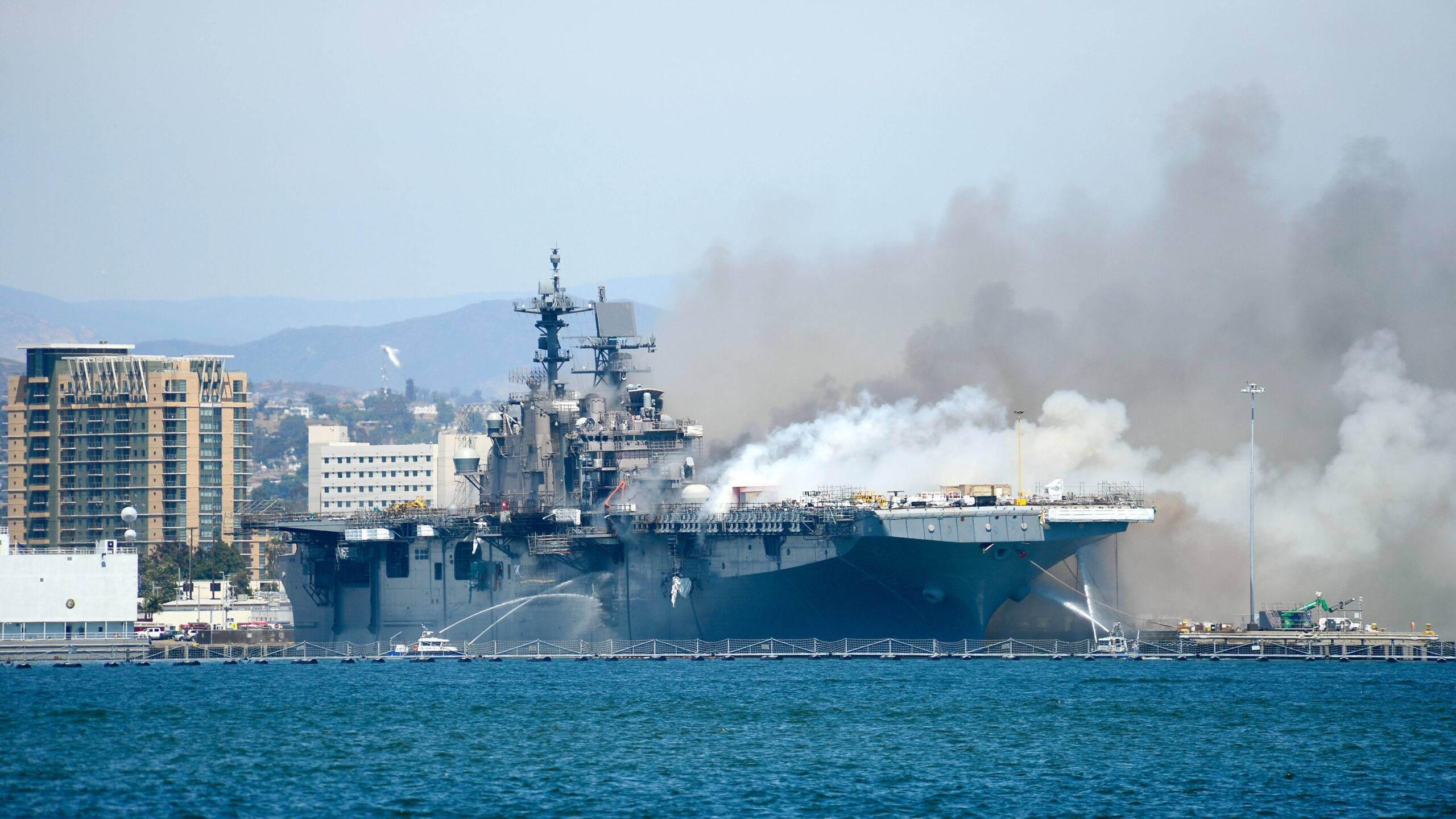
SAN DIEGO , CA – JULY 12: Port of San Diego Harbor Police Department boats combat a fire aboard the amphibious assault ship USS Bonhomme Richard (LHD 6) at Naval Base San Diego, July 12, 2020. (Photo by Lt. John J. Mike/U.S. Navy via Getty Images)
WASHINGTON: The loss of the Bonhomme Richard (LHD-6), a $3.5 billion amphibious warship destroyed by a fire in July 2020, was “clearly preventable” and “unacceptable,” the Navy’s second most senior officer Adm. Bill Lescher told reporters today.
Lescher’s comments came hours after the service published its command investigation into the crew members’ response to the fire, as well as a separate review of major fires the service has fought in recent history.
“The command investigation was an unflinching, unsparing and, by design, a widely scoped examination of how this fire resulted in the loss of the ship,” the vice chief of naval operations said. “It includes over 1,200 findings of fact, 242 opinions based on those facts and 139 recommendations for corrective actions at multiple levels throughout the Navy.”
RELATED: Navy Pushing Additional Safety Checks Following Bonhomme Richard Fire
The investigation was separate from a criminal prosecution against a crew member of the ship who is suspected to have started the fire intentionally out of spite for the military and who has been charged with “aggravated arson and hazarding a vessel,” the Navy said in a written statement. Dozens of servicemembers were injured as a result of the blaze. A hearing for that sailor is scheduled for mid-November, the Navy said.
The ultimate blame for actually losing the ship, however, fell on 36 individuals, according to the command investigation. Most of the names are redacted but a handful, such as the ship’s commodore Capt. Gregory Thoroman, Vice Adm. Richard Brown, commander of naval surface forces pacific, and two rear admirals responsible for fleet maintenance, are not. The Navy has convened a special authority that will work to determine what disciplinary actions those individuals may face.
The Navy’s investigation into the incident lays heavy blame on the crew and training failures, but the VCNO said the service’s own processes also left it vulnerable to this type of disaster.
“The major fires review also revealed that these major fires occur because of compound failures in our defense in depth design, failures that leaves us vulnerable to single fire events that can cascade into catastrophic consequences,” Lescher said. “The MFR also clearly illuminated that the Navy has not been consistently effective in sustaining corrective actions from previous fires over time.”
The investigation identified four factors that ultimately contributed to the Bonhomme Richard’s crew’s ineffective attempts to fight the fire, which lasted five days. The factors include the material condition of the ship, the training and readiness of the ship’s crew, the integration between the ship and supporting shore-based firefighting organizations, and the oversight by commanders across multiple organizations, according to the service.
In most years, the time between Congress passing the annual defense spending bill and the Pentagon publishing its next request takes several months, which means few or no military officers testifying on Capitol Hill. This year, however, Congress is certain to hold a series of hearings on what happened with the Bonhomme Richard and grilling Navy leadership on who will own the disaster.
Lawmakers are likely to reference the 2017 ship collisions of the John S. McCain and Fitzgerald. During hearings following those events, lawmakers became particularly irate with Navy brass who put too much blame on deck plate sailors rather than taking responsibility for what happened at the Pentagon’s level.
RELATED: Collisions Study Shows Navy Needs Better Training, More Ships, CNO Says
The response from Capitol Hill today was muted following the Navy publishing its investigation, with many key defense lawmakers not immediately speaking up.
Rep. Rob Wittman, Va., a prominent Republican on the House Armed Services Committee, called the incident a “faceplant.”
“Our sailors are trained to combat fires with a sense of urgency, and regrettably, this sense of urgency was present in the early hours of the blaze. Couple this with negligent attitudes towards cleaning, preservation and stowage, degraded operability of core fire-fighting systems, and insufficient resources, and you lose the ship,” he said in a statement.
GD chief says Navy’s 1 sub buy won’t impact company short term, but out years less certain
The comments from the General Dynamics chief come on the same day President Joe Biden signed the national security supplemental, which includes billions for the sub industrial base.



























